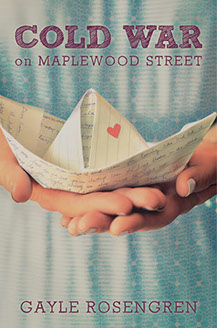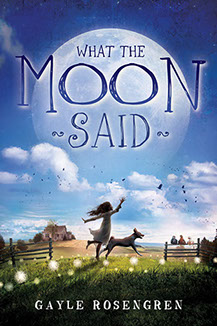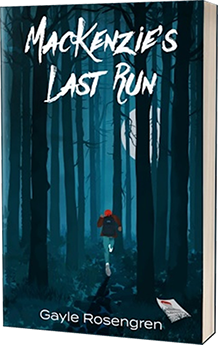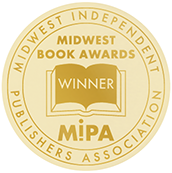"In an emotional, gripping, and important story, Rosengren shares what we rarely see years after a mass shooting: the long-term impact on the family left behind. Heart-pounding, fast-paced, and unputdownable, this story provides an eye-opening view into rebuilding life from the ashes of guilt and grief in order to redefine family, love, and, most of all, hope for a future."
"MacKenzie’s Last Run is a poignant story of loss, grief, healing, and hope that grabs you from the first page and doesn’t let go. In a family torn apart by sadness, MacKenzie can’t shake the idea that he’s to blame for his dad’s death. Unable to move on, he’s angry with his mom’s decision to remarry. Rosengren’s skillful writing makes our heart ache for MacKenzie and, indeed, his whole family, which also includes his twin sister Tessa. Well-written scenes confront the fact that on the page and in real life the dynamics of grief are tricky to navigate as we all process sorrow in different ways and times. Exceptionally plotted, Mac’s decisions spiral out of control, delivering one page turning moment after another. This is another beautiful, must-read story from Rosengren and one that will resonate with readers struggling with losses of their own."
-Valerie Biel, author of the award-winning Circle of Nine series
"MacKenzie’s Last Run, a page-turner appropriate for ages eleven and up, is expertly told in alternating points of view, shifting between thirteen-year-old Mac and his twin sister, Tessa. The twins lost their father during a mass shooting at a mall. Mac’s grief adversely affects his relationship with his twin and his mother. When his mother announces her intention to remarry, Mac plans to run away and force her to break the engagement. He steals off in the middle of the night, but almost immediately sustains injuries that will become life-threatening.
MacKenzie’s Last Run is a survival story of the best kind; one that shows both emotional and physical struggles. Sadly, it’s also a timely novel. Author Gayle Rosengren has dedicated it to all those who have lost a loved one through gun violence.
Recommended for those who enjoy suspense. Would make a great classroom read.
-Amy Laundrie, retired teacher, author of Stranded on Castaway Island
MacKenzie’s Last Run is a survival story that explores the aftermath of tragedy and the myriad of ways we carry its echoes with us. When Mac and Tessa’s father is killed by a mass shooter, their lives shatter. Not only do they miss him deeply, but things between them have soured as well, spoiling the bond they’ve always shared as twins. Mac has spiraled into anger that Tessa can’t fully understand, and she feels hurt and left behind. But Mac can’t bear to admit what’s really behind his anger: he blames himself for his father’s death. When their mother gets engaged, it’s the last straw for Mac. He runs away, hoping the desperate act will make his mother change her mind about the marriage. But when Mac is hurt, things go wrong fast, and he suddenly finds himself struggling to survive long enough to make it home.
Mass shootings are a difficult topic, so we don’t see them explored often. Unfortunately, they’ve become something our kids are all too familiar with. Active shooter drills are commonplace now, and many people have been directly and indirectly affected by mass shootings in this country. This book tackles the fear head-on, but it does so in a way that most kids will be able to process. Mac’s harrowing survival story takes center stage and helps take the focus off the bigger theme of the pain of Mac’s loss without watering it down. Since we see the story through both Mac’s and Tessa’s eyes, we get two different perspectives on how loss is processed, which is also great for kids to see. The book focuses on the bonds of family and the ways those ties can be tested (and how they survive and thrive). And as Mac’s situation gets more and more tenuous, kids will find themselves flipping those pages faster and faster to find out just what will happen next!
BOTTOM LINE: A riveting story of survival in the face of painful loss.
-Nicole M. Hewitt, Middle Grade writer and host of Feed Your Fiction Addiction blog.


The Tofte/Wright Children’s Literature Award is conferred once a year by the Council for Wisconsin Writers to a book written by a Wisconsin Author.
The Reviews are in!
Bulletin of the Center for Children’s Books:
Cold War on Maplewood Street
"It’s 1962 and Joanna has a lot on her mind: the concerns of sixth grade (boy-girl parties, fake nails, and what to say to the cute boy), the struggles of her single mother, and the scary old woman who lives above Joanna’s basement apartment. Heavier on her mind than any of these, though, is the departure of her beloved brother Sam, who enlisted in the Navy, breaking a promise to Joanna that he would never leave her. Her feelings of hurt and betrayal become ones of intense worry as the Cuban Missile Crisis erupts with Sam smack dab in the action. Very much a growing child’s view of the world, and very much of an era (Joanna’s love of Top 40 music adds nice atmospheric detail), this historical novel is both compelling and relatable; readers may not know the fear of needing a shelter room in the event of nuclear war, but they’ll appreciate Joanna’s determination to create such a space and admire her all the more because she does it alone. In uncluttered, almost simplistic prose, Rosengren takes complicated issues of abandonment and war and makes them approachable while still packing an emotional wallop. Put this in the hands of history buffs and fans of serious domestic realism in deceptively simple form. AA"
Voya:
Cold War on Maplewood Street
"The Cuban Missile Crisis of 1962 casts a daunting shadow over America as young Joanna struggles with the cold war occurring in her life and the lives of those around her. Joanna is a sixth grader living with her mother in a small apartment on Maplewood Street. Her life is pretty typical for a young girl living in the early sixties. She has an innocent crush on a boy, worries about her creepy neighbor Mrs. Strenge, and spends much of her time with her best friend Pamela. She harbors resentment towards her older brother Sam for “deserting” her and her mother to join the navy after her father did so in her early childhood. Her feelings of abandonment are so powerful that they prevent her from answering any of her brother’s many letters to her. When she hears the president announce that there are Soviet missiles in Cuba, she worries for her brother’s safety. As those around her struggle with the looming possibility of a nuclear war, her worries mesh with the chorus of emotions surrounding her. Her small corner is a microcosm of a world sitting at the brink of nuclear disaster.
This story is an eloquent portrayal of the worries of a child at such a terrifying time. There are not many stories for young adults that take place during this tense time in history and Rosengren’s does a lovely job of reflecting the mood at the time. While not gripping, her story is moving and gives young readers a glimpse into a very unique era when the future of the country was uncertain.—Victoria Vogel."
Publishers Weekly:
Cold War on Maplewood Street
Review Issue Date: 08/04/2015
"Drawing from her own childhood memories, Rosengren (What the Moon Said) writes a quietly tense story set during the Cuban Missile Crisis. Joanna’s father abandoned her family when she was four, and her older brother, Sam, promised never to leave her. But he joined the navy right out of high school with the aim of seeing the world before going to college on the GI Bill. Joanna is furious, sad, and—lately—fearful, and she stubbornly ignores the letters Sam sends. With her mother busy working and taking night classes, Joanna is left alone in their basement apartment, which is bad for her wild imagination. Joanna’s frustrations and worries include potential burglars, a “strange” elderly neighbor, Sam’s fate overseas, and her mother’s refusal to let her attend her first “boy–girl party,” but she learns how to muster courage during a time of accelerated, unwanted change. Rosengren’s judicious use of details evokes a strong sense of the 1960s, and while some readers will already be aware of how history played out, they’ll find it easy to share Joanna’s feelings of nervousness, helplessness, and hope. Ages 8–12. (Aug.)"
Booklist
Cold War on Maplewood Street
"Joanna, a latchkey kid whose father left when she was four, now feels abandoned by her beloved brother Sam, who joined the navy four months earlier. Hurt and sulking, she refuses to answer his letters. Meanwhile, she deals with her anxiety about burglars, hangs out with her best friend, and bickers with her mother about wearing makeup and attending boy-girl parties. But when the Cold War heats up during the week of the Cuban missile crisis, Joanna worries about her brother’s safety as well as her own. As true to the period as the many references to 1960s songs and TV shows, the intensifying fear of nuclear war affects adults as well as Joanna and her friends during the seven-day span of the novel. In an author’s note, Rosengren relates that her experiences as a 12-year-old during the Cuban missile crisis inspired the book. This accessible, competently written novel portrays a young character living through a national crisis that precipitates personal growth. — Carolyn Phelan"
February School Library Connection:
Cold War on Maplewood Street
"Rosengren's second novel blends realistic fiction and history; it addresses the life of Joanna at the beginning of the Cuban Missile Crisis. Joanna’s older brother has recently enlisted in the Navy; she finds out that his ship is on the front line. Joanna also has to deal with many issues such as friendship and growing up. The plot moves quickly; Rosengren is able to take a complex subject and personalize it for students. This title would be a great addition to any school or public library or for use in an English or Social Studies course. Jennifer Flaherty, Teacher Librarian, Beachwood (Ohio) High School [Editor’s Note: Available in e-book format.] Recommended"

Awards won by What the Moon Said:
What the Moon Said Reviews
Publishers Weekly:
What The Moon Said
"A ring around the moon, a dream about a wedding, and rain at the outset of a journey are all causes for alarm in the mind of Esther Vogel's Russian immigrant mother. Her superstitions, combined with a lack of physical affection, make (nearly) ten-year-old Esther wonder if Ma loves her. In 1930, Esther's life changes dramatically when her family moves from Chicago to a Wisconsin farm after her father loses his job. The house is dilapidated, with no electricity and an outhouse instead of a bathroom. Optimistically determined to see the situation as an "adventure," Esther is thrilled to have horses, cows, and (best of all) a dog, and she finds beauty in the quiet landscape and excels in school. Yet what she really wants—approval, a steady best friend, and relief from poverty—are elusive. Rosengren, in her first novel, offers an intimate account of a family's adjustments to country life and the hardships of the Great Depression. It's easy to root for Esther, who makes the most of each day, wants little and gives much. Ages 8-12."
Kirkus:
What The Moon Said
Review Issue Date: December 15, 2013
"A coming-of-age tale gets to the heart of family dynamics in the face of drastic life changes in the earliest days of the Depression.
Esther’s family moves to a farm in Wisconsin when her father loses his job. She comes to like farm life in spite of the hardships of a house with no electricity, an outhouse instead of a bathroom and lots of chores. But her overwhelming mission is to win her mother’s love by being obedient and helpful, for she believes that her mother doesn’t really love her, as she never hugs or kisses the girl and seems to recoil from any display of affection from her. Esther’s mother sees dangerous omens everywhere: in dreams, in the configuration of the moon and in small daily occurrences. Some of these beliefs cause even more painful difficulties in their relationship, as when she demands that Esther end a friendship when she sees the girl has a mole that is, to her, the mark of angry fairies. Esther is often confused, but she’s able to withstand everything that happens with resilience and a measure of hope. Every episode, whether ordinary or momentous, fills in a bit of the puzzle and leads Esther and readers to a growing understanding and acceptance of the nature of love and home and family ties. It’s a quiet, old-fashioned story; Bean’s black-and-white chapter heads reinforce its cozy, mid-20th-century feel. Sensitive and tender. (Fiction. 8-12)"
Booklist
What The Moon Said
"When Depression-era hard times send Esther's family from their Chicago home to try their luck on a small Wisconsin farm, the 10-year-old learns that there are many ways people show love. Esther's mother never hugs or kisses her. Does she even love her? Over the course of their year in the country, Esther tries desperately to be a good daughter, but the practical realities of their near-pioneer life (no electricity or running water) leave her mother little time to notice. And while the bookish child admires her fearful mother's abilities to read signs, she can't bring herself to give up her new friend Bethany, even if her mother says th girl was marked by angry fairies. Eventually, Esther finds much to enjoy in her new farm life. Debut author Rosengren weaves plenty of Old World superstitions into her heartwarming story, contrasting those who fear the future with those who embrace it. Esther's positive attitude offers a fine model for readers of this engaging historical fiction. —Kathleen Isaacs."





